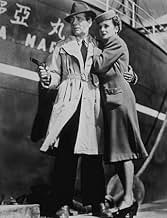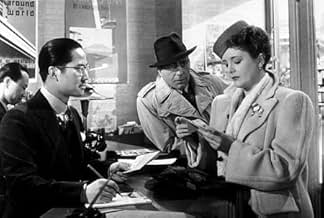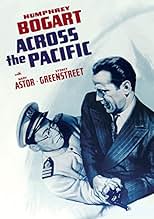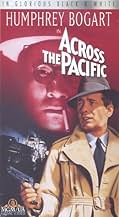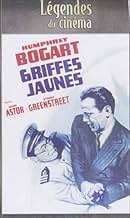IMDb RATING
6.8/10
5.6K
YOUR RATING
In December 1941, ex-army captain Rick Leland boards a Japanese ship heading to Asia via the Panama Canal where his Japanese hosts show interest in the American defense plans for the canal z... Read allIn December 1941, ex-army captain Rick Leland boards a Japanese ship heading to Asia via the Panama Canal where his Japanese hosts show interest in the American defense plans for the canal zone.In December 1941, ex-army captain Rick Leland boards a Japanese ship heading to Asia via the Panama Canal where his Japanese hosts show interest in the American defense plans for the canal zone.
- Directors
- Writers
- Stars
- Awards
- 1 win & 1 nomination total
Victor Sen Yung
- Joe Totsuiko
- (as Sen Young)
Lee Tong Foo
- Sam Wing On
- (as Lee Tung Foo)
- Directors
- Writers
- All cast & crew
- Production, box office & more at IMDbPro
Featured reviews
Richard Macaulay had to do some fast rewrites on this John Huston-directed picture, based upon a magazine serial by Robert Carson. When dishonorably discharged Army Officer Humphrey Bogart is revealed to be a spy staking out a powerful Japanese sympathizer aboard a vessel to the Orient, the portly commander was originally supposed to be supervising the bombing of Pearl Harbor. When that occurred in real-life while the picture was in production, Macaulay hurriedly switched the locale to the Panama Canal (making the film's title irrelevant). However, even if the story structure is patchy--and Mary Astor's role as a plantation owner's daughter ultimately doesn't make much sense--"Across the Pacific" has a dryly joshing quality about it, and the end results are pleasant if unremarkable. Bogart (playing 'Rick', sometimes 'Ricky') is in jovial spirits throughout, especially when comparing gun sizes with Sydney Greenstreet (never better) or fingering Astor's back after she's acquired a sunburn; his blithe, easy performance makes the film enjoyable. Astor (ostensibly the love-interest) doesn't pour on the charm in her scenes with Bogie; she plays it rather big-sisterly with him, a seen-it-all kind of gal, and this works extremely well. The finale is a sign of the times--American fighter planes fill the skies--but even this corny touch works a little magic, despite the film's misshapen quality and sluggish beginning. **1/2 from ****
A good spy caper starring Humphrey Bogart as Rick Leland, a court-martialled US Army officer who finds himself in the middle of a nifty little bit of espionage work on board a Japanese freighter bound from Halifax to Yokohama via the Panama Canal just before the attack on Pearl Harbour. Surrounded by a rather suspicious group of characters, from his love interest Alberta Marlow (Mary Astor) to Dr. Lorenz (Sydney Greenstreet), Leland slowly uncovers a Japanese plot to attack the Canal Zone (presumably also on December 7) and sets himself to preventing it.
This was a good performance by Bogart, along with good performances from Astor and Greenstreet. (For those not entirely familiar with Canadian geography, by the way, the pun is that Alberta claims to be from Medicine Hat, which is a small city in Alberta - almost TOO cute!) There's a fair amount of tension throughout as we struggle along with Leland to figure out exactly what's going on, and a nice climax as Leland foils the Japanese plan (Bogey had to win!)
A couple of things I thought were worth noting, though. First of all, what's with the title? All the action in the movie takes place either on the Japanese freighter as it travels south down the ATLANTIC coast of North America or in the Panama Canal Zone (with some minor scenes in Halifax, where Leland is rejected by the Canadian Army, and in New York City, where he snoops for information.) The only Pacific connection to the movie is that the freighter was Japanese. And remember, of course, that this was made in 1942 (after Pearl Harbour.) The depiction of the Japanese isn't especially flattering (although I thought it was more a play on stereotypes than openly antagonistic), and the closing shot of the film is the wartime requisite showing off of American military strength.
All in all, though, I enjoyed this movie immensely, and would highly recommend it.
8/10
This was a good performance by Bogart, along with good performances from Astor and Greenstreet. (For those not entirely familiar with Canadian geography, by the way, the pun is that Alberta claims to be from Medicine Hat, which is a small city in Alberta - almost TOO cute!) There's a fair amount of tension throughout as we struggle along with Leland to figure out exactly what's going on, and a nice climax as Leland foils the Japanese plan (Bogey had to win!)
A couple of things I thought were worth noting, though. First of all, what's with the title? All the action in the movie takes place either on the Japanese freighter as it travels south down the ATLANTIC coast of North America or in the Panama Canal Zone (with some minor scenes in Halifax, where Leland is rejected by the Canadian Army, and in New York City, where he snoops for information.) The only Pacific connection to the movie is that the freighter was Japanese. And remember, of course, that this was made in 1942 (after Pearl Harbour.) The depiction of the Japanese isn't especially flattering (although I thought it was more a play on stereotypes than openly antagonistic), and the closing shot of the film is the wartime requisite showing off of American military strength.
All in all, though, I enjoyed this movie immensely, and would highly recommend it.
8/10
This serves as a nice companion piece to "The Maltese Falcon", but DON'T compare it the masterpiece or you won't enjoy it. Also, keep in mind, this was during the beginning of WWII (obviously), so expect your typical "all Japanese are evil" racial stereotypes. It is upsetting to see that films like these just heightened the US's paranoia, driving us to send everyone of Japanese descent to internment camps.
You're going to really enjoy this film if you've seen modern Pulp adventures like the Indiana Jones trilogy or Sky Captain (though don't expect to see ANY mystical/sci-fi elements involved). This has it all: a hard-boiled hero, exotic locales, constant plot twists and turns, colorful villains, and a mysterious woman.
Bogart, as (almost) always plays the same character he always plays. but boy, does he fit in SO well into this film. Mary Astor, while not the pretty face that she was built up to be here and in "The Maltese Falcon", gives another great performance, and unlike Bogart, she was always able to give characters in a similar vein (in this case, the mysterious woman), each their own personalities. Her Alberta Marlow is not at all like "schoolgirl" Brigid O'Shaughnessey, but (at least openly) tougher, a perfect match with Bogart during their exchanges of dialogue, while remaining to be extremely ambiguous, never making sure whether or not she's an ally or a femme fatale. When all is revealed, looking back on it things made perfect sense with her character's attitude.
Sydney Greenstreet adds another great villain to his own rogues gallery. Here he's a man obsessed with Japanese culture and way of life, so much that he has become apart of and accepted by "the enemy". Victor Sen Young, who played a great shark grinned scumbag in "The Letter", does good here, looking very happy that he at least was able to speak coherently for once in a motion picture.
Huston's direction is really worth looking at, especially visually stunning during a sequence at a movie theater. Without his obvious presence and Bogart, this film would have just been another propaganda story of espionage. Sadly, when he had to leave the film for war duty, the final scenes were shot by otherwise competent (but nothing special) director Vincent Sherman. The final 15 minutes seem extremely out of place with the rest of the film, and its a shame Huston wasn't around a little bit longer to round up what could have been a quintessential piece of a feature 40's pulp movie.
Worth seeing, its a film that falls short of greatness, but man is it entertaining.
You're going to really enjoy this film if you've seen modern Pulp adventures like the Indiana Jones trilogy or Sky Captain (though don't expect to see ANY mystical/sci-fi elements involved). This has it all: a hard-boiled hero, exotic locales, constant plot twists and turns, colorful villains, and a mysterious woman.
Bogart, as (almost) always plays the same character he always plays. but boy, does he fit in SO well into this film. Mary Astor, while not the pretty face that she was built up to be here and in "The Maltese Falcon", gives another great performance, and unlike Bogart, she was always able to give characters in a similar vein (in this case, the mysterious woman), each their own personalities. Her Alberta Marlow is not at all like "schoolgirl" Brigid O'Shaughnessey, but (at least openly) tougher, a perfect match with Bogart during their exchanges of dialogue, while remaining to be extremely ambiguous, never making sure whether or not she's an ally or a femme fatale. When all is revealed, looking back on it things made perfect sense with her character's attitude.
Sydney Greenstreet adds another great villain to his own rogues gallery. Here he's a man obsessed with Japanese culture and way of life, so much that he has become apart of and accepted by "the enemy". Victor Sen Young, who played a great shark grinned scumbag in "The Letter", does good here, looking very happy that he at least was able to speak coherently for once in a motion picture.
Huston's direction is really worth looking at, especially visually stunning during a sequence at a movie theater. Without his obvious presence and Bogart, this film would have just been another propaganda story of espionage. Sadly, when he had to leave the film for war duty, the final scenes were shot by otherwise competent (but nothing special) director Vincent Sherman. The final 15 minutes seem extremely out of place with the rest of the film, and its a shame Huston wasn't around a little bit longer to round up what could have been a quintessential piece of a feature 40's pulp movie.
Worth seeing, its a film that falls short of greatness, but man is it entertaining.
WWII intrigue is served up in the days leading up to the bombing on Pearl Harbor. However, in an apparent late decision by the writers to not mention Pearl Harbor, the bombing target becomes Panama so history can be ignored. Bogart is cool as always as an artillery officer. He is reunited with his co-stars, Astor and Greenstreet, both in fine form, and director Huston from "The Maltese Falcon." Unfortunately, the script is rather convoluted and rambling, seemingly written in a rush to cash in on the success of the earlier film. The dialog is crisp and witty. If only the plot had been better, this could have been a classic.
This film is okay -- watchable and even interesting -- but one can't help comparing it to "The Maltese Falcon" which appeared the previous year. Same principle actors -- Bogart, Mary Astor, Sidney Greenstreet -- no Peter Lorre fondling the handle of his cane, alas, and no gunsel -- and, for the most part, the same Director, John Huston. Huston was called up for Signal Corps duty halfway through filming and as a gag shot the scenes up to the point at which Bogart was strapped helplessly into a chair and surrounded by armed guards, a situation seemingly without the possibility of escape. Then Huston cheerfully said goodbye and walked off the set, leaving his replacement, Vincent Sherman, to try to figure out how to get Bogart free.
It may be unfair to compare "Across the Pacific" to a lucky shot like "The Maltese Falcon," but this film invites the comparison. Not just the same performers but similar lines -- "You're good, Angel, very, very good." But in Falcon the actors fit their fictional characters like enzymes accommodating themselves to a substrate. Here they are just actors playing familiar roles: the obese villain, the officer who's dishonorable discharge is faked so he can go undercover (Gary Cooper could have done as well, and in fact DID in a later movie), the innocent woman made to look bad because the enemy has imprisoned her dissolute father. The Japanese are all plain-vanilla bad guys, even the familiar young one who makes amusing wisecracks in American slang. And all the Japanese have real names like Tong, Chan, Loo, Fong, and Ahn. (To be fair, the last one is Korean, not Chinese.)
If the characters are not nearly as much fun to watch as in "The Maltese Falcon," the plot is no more than a simple war-time mystery involving secret information that the Japanese want to use to start the war by torpedoing the locks of the Panama Canal. Actually, the Japanese did develop such plans later in the war. They intended to deliver a handful of torpedo planes to the vicinity of the Canal in huge submarines, which were available. The planes were not, and the plans folded when the war ended.
In the movie, the characters move from New York to Canada, then board a Japanese steamer, back to New York, then to Panama, where they disembark. They travel from the Atlantic side of the canal to the Pacific -- but they never make it across the Pacific.
It may be unfair to compare "Across the Pacific" to a lucky shot like "The Maltese Falcon," but this film invites the comparison. Not just the same performers but similar lines -- "You're good, Angel, very, very good." But in Falcon the actors fit their fictional characters like enzymes accommodating themselves to a substrate. Here they are just actors playing familiar roles: the obese villain, the officer who's dishonorable discharge is faked so he can go undercover (Gary Cooper could have done as well, and in fact DID in a later movie), the innocent woman made to look bad because the enemy has imprisoned her dissolute father. The Japanese are all plain-vanilla bad guys, even the familiar young one who makes amusing wisecracks in American slang. And all the Japanese have real names like Tong, Chan, Loo, Fong, and Ahn. (To be fair, the last one is Korean, not Chinese.)
If the characters are not nearly as much fun to watch as in "The Maltese Falcon," the plot is no more than a simple war-time mystery involving secret information that the Japanese want to use to start the war by torpedoing the locks of the Panama Canal. Actually, the Japanese did develop such plans later in the war. They intended to deliver a handful of torpedo planes to the vicinity of the Canal in huge submarines, which were available. The planes were not, and the plans folded when the war ended.
In the movie, the characters move from New York to Canada, then board a Japanese steamer, back to New York, then to Panama, where they disembark. They travel from the Atlantic side of the canal to the Pacific -- but they never make it across the Pacific.
Did you know
- TriviaDirector Vincent Sherman met with John Huston just before Huston left the project to join the United States Army Signal Corps to shoot documentaries for the war effort.
The two directors conferred just before they were about to shoot the scene in which Leland is trapped in the movie theatre and three assassins are trying to kill him.
"How does he get out?" Sherman asked. Huston replied, "That's your problem! I'm off to the war!"
John Huston then went off to join the war effort before the film was finished, taking the film script with him, explaining "Bogie will know how to get out." The studio's solution to the problem was to discard Huston's footage of the impossible dilemma and write a new scenario. Vincent Sherman directed the final scenes.
- GoofsThe background for the opening titles is a map of the Panama Canal. The orientation of the map and the compass is correct, but the labeling of the map is incorrect. In fact, the Atlantic end of the canal and the city of Colon are at the upper left (Northwest), and the Pacific end of the canal and Panama City are at the lower right (Southeast). The map is correctly labeled behind the closing credits.
- Quotes
Rick Leland: [comparing his gun to Dr. Lorenz's, which he points at him] Remember: mine is bigger than yours!
- Crazy creditsOpening Card:
Governor's Island
New York
- Alternate versionsAlso available in a computer colorized version.
- ConnectionsFeatured in Frances Farmer Presents: Across the Pacific (1959)
- How long is Across the Pacific?Powered by Alexa
Details
- Runtime
- 1h 37m(97 min)
- Color
- Aspect ratio
- 1.37 : 1
Contribute to this page
Suggest an edit or add missing content


